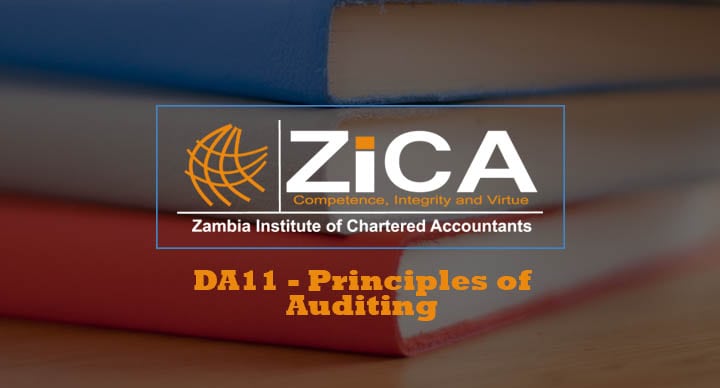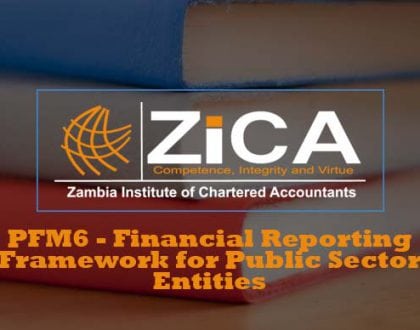DA11-Principles of Auditing
No access plans exist.

Course Features
Course Details
DA11-Principles of Auditing
Learning Outcomes
On successful completion of D11, students should be able to:- Explain the purpose and context of external audit and other assurance engagements
- Explain the principles of good corporate governance, and apply professional and ethical codes in specified circumstances
- Explain the nature of internal audit and its relationship with external audit
- Demonstrate how an auditor plans an audit in accordance with International Standards on Auditing
- Evaluate the effectiveness of systems of internal control and assess control risks and their potential consequences
- Explain the audit evidence that the auditor requires to meet the objectives of the audit in accordance with International Standards on Auditing
- Identify and describe the audit evidence and work that would be required in relation to specified areas of an audit conducted in accordance with International Standards on Auditing
- Evaluate the findings of the audit and assess their potential impact on the auditor’s report
| Topic | Weighting |
| Purpose and context of audit | 5% |
| Corporate governance and codes of ethics | 10% |
| Internal audit | 5% |
| Audit planning, risk and documentation | 15% |
| Internal control | 20% |
| Audit evidence – techniques | 15% |
| Audit evidence – specific areas | 20% |
| Review and reporting | 10% |
Content
-
Purpose and Context of Audit
- Concept of audit and assurance
- Explain the nature and objectives of audit and assurance
- Explain the concepts of accountability, stewardship, agency, true and fair and reasonable assurance
- Explain the five elements of an assurance engagement
- Describe the function of an external audit in the context of the regulatory framework within which statutory audits take place
- Explain the mechanisms by which auditors are regulated
- Describe the development and status of International Standards on Auditing
- Describe the nature of assurance engagements other than the statutory external audit
- Appointment, removal and resignation of the auditors
- Explain the regulations which govern the appointment, removal and resignation of auditors
- Auditor rights and duties
- Explain the rights and duties of an auditor
- Explain the importance of rights and duties of an auditor
- Concept of audit and assurance
-
Corporate Governance and Codes of Ethics
- Purpose and principles of good corporate governance
- Explain the aims and importance of good corporate governance
- Describe the structure and functions of the board of directors (those charged with governance)
- Explain the need for communication between the auditor and those charged with governance
- Explain the provisions made by international codes of corporate governance (such as the UK Corporate Governance Code) that are relevant to auditors
- Explain directors’ reporting responsibilities and auditors’ reporting responsibilities
- Describe the structure and function of audit committees (including other board committees) and their benefits and drawbacks
- Explain why internal control and risk management are important for good corporate governance
- Distinguish between the responsibilities of management and those of auditors in relation to the design and operation of systems and controls
- Apply corporate governance principles to simple cases
- Codes of professional ethics (M)
- Explain the aims and importance of the fundamental principles of professional ethics
- Explain the fundamental principles of professional ethics (Integrity, objectivity, professional competence and due care, confidentiality and professional behaviour)
- Explain the conceptual framework, including the threats to the fundamental principles of self-interest, self- review, advocacy, familiarity and intimidation.
- Identify threats to ethical behaviour in given scenarios
- Apply relevant safeguards to mitigate threats to the fundamental principles
- Describe the auditor’s responsibility with regard to auditor independence, conflicts of interest and confidentiality
- Explain the preconditions that must be present for an audit to take place
- Explain the requirements of professional ethics in relation to the acceptance of new audit engagements
- Explain the process by which an auditor obtains an audit engagement
- Explain the importance of engagement letters
- State the contents of engagement letters
- Purpose and principles of good corporate governance
-
Internal Audit
- Differences between external audit and internal audit
- Distinguish between the roles of external and internal audit regarding audit planning and the collection of audit evidence
- Explain the importance of the independence of the internal audit function
- Internal audit: scope, limitations, assignments and reporting
- Identify the factors to take into account when assessing the need for internal audit
- Describe best practice in internal audit with reference to appropriate international codes of corporate governance
- Identify the scope and limitations of internal audit
- State the advantages and disadvantages of outsourcing the internal audit function
- Explain the respective responsibilities of internal and external auditors in relation to fraud and error
- Explain the process of producing an internal audit report
- Describe the format and content of internal audit reports
- Using the work of internal audit
- Explain the nature and purpose of internal audit assignments (such as value for money audits, management audits, IT and procurement audits etc.)
- Explain the extent to which external auditors may rely on work done by internal auditors
- Differences between external audit and internal audit
-
Audit planning, Risk and Documentation
- Audit planning Explain the need for audit planning
- Distinguish between the overall audit strategy and the detailed audit plan
- Distinguish between an interim and a final audit
- Introduction to risk
- Define audit risk
- Define business risk
- Explain the importance of audit risk and business risk
- Explain the risk of material misstatement
- Audit documentation
- Explain why audit documentation is kept
- Describe the contents of audit documentation
- Describe the procedures necessary to ensure safe custody and retention of audit documentation
- Audit planning Explain the need for audit planning
-
Internal Control
- Internal control: control environment and activities (M)
- Define internal control
- Explain control objectives
- State why internal control is relevant to the external audit
- Explain the components of an internal control system
- Distinguish between tests of controls and substantive procedures
- Identify the limitations of internal controls in relation to fraud and error
- Testing of internal control by external auditors (M)
- Describe how auditors record internal control systems
- Identify deficiencies in internal control systems (sales, purchases, inventory, payroll, bank and cash and capital expenditure) and how they limit the reliance that can be placed on those systems by external auditors
- Suggest appropriate recommendations to deficiencies in internal control systems
- Illustrate computer controls with examples
- Explain how the reporting of deficiencies in internal control and recommendations to mitigate them are provided to management
- State why smaller entities may have different levels of internal control compared to larger entities and state the effect this may have on the audit evidence required for the audit of a smaller entity
- Tests of controls over specific accounting systems – sales, purchases, inventory, wages and cash (M) For each system:
- Describe control objectives, control activities and control procedures
- Describe tests of controls
- Internal control: control environment and activities (M)
-
Audit Evidence – Techniques
- Audit evidence and sampling
- Define audit evidence
- Define audit sampling
- Distinguish between statistical and non-statistical sampling
- Explain statistical sampling and other selective testing procedures
- Audit evidence and financial statement assertions (M)
- Explain the financial statement assertions
- Explain techniques for gathering audit evidence
- Identify audit evidence in terms of its quantity and quality
- Identify audit evidence in terms of its relevance and reliability
- Explain the relationship between financial statement assertions and audit evidence
- Audit procedures
- Explain substantive procedures in obtaining audit evidence
- Explain how substantive analytical procedures can be used to obtain audit evidence
- Illustrate the use of substantive procedures including analytical procedures in obtaining audit evidence
- Accounting estimates
- Define accounting estimates
- Provide examples of accounting estimates
- Explain the risks associated with auditing accounting estimates
- Computer Assisted Audit Techniques (CAATs)
- State how computer-assisted audit techniques are used in an audit
- Explain the use of test data and audit software for specified transaction cycles and balances
- Audit evidence and sampling
-
Audit Evidence – Specific areas:
In respect of each area, identify and explain relevant substantive procedures and their purposes in relation to the financial statement assertions- Tangible non-current assets
- Non-current asset register
- Asset verification
- Valuation reports
- Inventory
- Inventory counting procedures
- Cut-off
- Direct confirmation of inventory held by third parties
- Receivables
- Direct confirmation (circularisation)
- Relationship with credit sales
- Cash and bank
- Cash count
- Bank confirmation letters
- Payables and accruals
- Supplier statement reconciliations, direct confirmations
- Cut off
- Non- current liabilities
- Conditions of loan agreements
- Relationship with interest payments
- Share capital, reserves and directors emoluments
- (Shareholders’ register
- Compliance with legal provisions
- Disclosure of directors’ emoluments
- Introduction to audits of Not for Profit organisations
- Define not for profit organisations
- Identify examples of not for profit organisations
- Explain the potential problems in auditing not for profit organisations
- Tangible non-current assets
-
Review and Reporting
- Subsequent events
- Explain the purpose of, and procedures for, a subsequent events review
- Distinguish between the responsibilities of auditors and management regarding subsequent events
- Going concern
- Explain the importance of the concept of going concern, and the need for going concern reviews
- Distinguish between the responsibilities of auditors and management regarding going concern
- Written representations
- Explain the purpose of and procedures for obtaining written representations
- Explain the reliability of written representations as evidence
- Identify matters on which written representations are necessary and are obtained
- Overall review of financial statements
- Explain the importance of the overall audit review
- Define uncorrected misstatements
- Explain the significance of uncorrected misstatements
- The auditor's report on financial statements
- Explain the importance of audit reports
- Describe the format and content of the unmodified auditor’s report
- Describe the format and content of modified auditors’ reports
- Define and explain the use of emphasis of matter paragraphs and other matters paragraphs in the auditor’s report
- Reports to management
- Explain reports to management
- Describe the format and content of reports to management
- Subsequent events
Format of the exam
| Section | Marks |
| Section A: 2 compulsory questions, 25 marks each | 50 |
| Section B: Any 2 out of 3 questions, 25 marks each | 50 |
| TOTAL | 100 |
Recommended reading
- ZiCA D11 Principles of Auditing Study Manual
- Handbook of International Quality Control, Auditing, Review, Other Assurance, and Related Services Pronouncements (International Auditing and Assurance Standards Board, 2015)
- Handbook of the Code of Ethics for Professional Accountants (International Ethics Standards Board for Accountants, 2015)
Applicable ISAs and Other Documents
| ISA No | Name |
| 200 | Overall Objectives of the independent Auditor and the Conduct of an Audit in Accordance with International Standards on Auditing 210 Agreeing the terms of Audit Engagements |
| 220 | Quality Control for an Audit of Financial Statements |
| 230 | Audit Documentation |
| 240 | The Auditor's Responsibilities Relating to Fraud in an Audit of Financial Statements |
| 250 | A Consideration of Laws & Responsibilities in an Audit of Financial Statements |
| 260 | (Revised) Communication with Those Charged with Governance |
| 265 | Communicating Deficiencies in Internal Control to Those Charged with Governance and Management ISA No Name |
| 300 | Planning an Audit of Financial Statements |
| 315 | (Revised) Identifying and Assessing the Risks of Material Misstatement Through Understanding the Entity and its Environment |
| ISA No | Name |
| 320 | Materiality in Planning and Performing an Audit |
| 330 | The Auditor's Responses to Assessed Risks |
| 402 | Audit Considerations Relating to an Entity Using a Service Organisation |
| 450 | Evaluation of Misstatements Identified during the Audit |
| 500 | Audit Evidence |
| 501 | Audit Evidence - Specific Considerations for Selected Items |
| 505 | External Confirmations |
| 510 | Initial Audit Engagements – Opening Balances |
| 520 | Analytical Procedures |
| ISA No | Name |
| 530 | Audit Sampling |
| 540 | Auditing Accounting Estimates, Including Fair Value Accounting Estimates, and Related Disclosures |
| 550 | Related Parties |
| 560 | Subsequent Events |
| 570 | (Revised) Going Concern |
| 580 | Written Representations |
| 610 | (Revised) Using the Work of Internal Auditors |
| 620 | Using the Work of an Auditor Expert |
| 700 | (Revised) Forming an Opinion and Reporting on Financial Statements |
| ISA No | Name |
| 701 | Communicating Key Audit Matters in the Independent Auditor’s Report |
| 705 | (Revised) Modifications to the Opinion in the Independent Auditor's Report |
| 706 | (Revised) Emphasis of Matter Paragraphs and Other Matter Paragraphs in the Independent Auditor's Report |
| 710 | Comparative Information – Corresponding Figures and Comparative Financial Statements |
| 720 | (Revised) The Auditor’s Responsibilities Relating to Other Information in Documents Containing Audited Financial Statements Other ISQC 1 Quality Control for Firms that Perform Audits and Reviews of Financial Statements and Other Assurance and Related Services Engagements Glossary of Terms |
This course does not have any sections.






I intend to study the course ( DA11),how do I access the past papers,Study material and revision kit. Iam based in Solwezi